Wood-boring insects are scary to have in your home. They are hard to identify, and often once they are identified, they have caused significant damage.
But, how do you determine if you have carpenter ants if they nest inside wood? Don’t worry; in this post, we will go over seven different types of carpenter ant damage that you can use to identify infestations before they cause significant damage.
Let’s get started.
1. Tunnels or Galleries
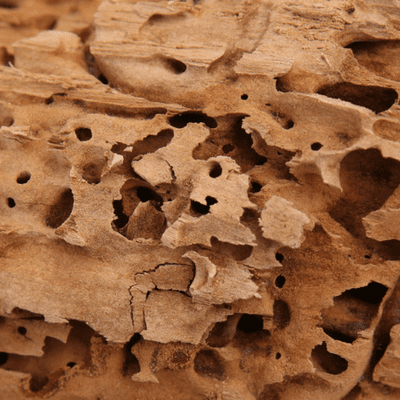
Tunnels and galleries are one of the most common signs of carpenter ants.
They create these tunnels after they excavate wood to create their nests inside any damaged or decaying wood around your home.
These tunnels are unique from termites because they are smooth. In contrast, termite tunnels are typically rough. If you find smooth tunnels or galleries on any wood around your home, this is a clear sign of carpenter ants.
These tunnels can be flush with the surface of the wood, or they can be inside the core of the wood. Depending on the location of the tunnels, it can be difficult to find these tunnels.
Carpenter ants create tunnels that go with the grain and are smooth and are around ¼ of an inch.
2. Hollow Wood
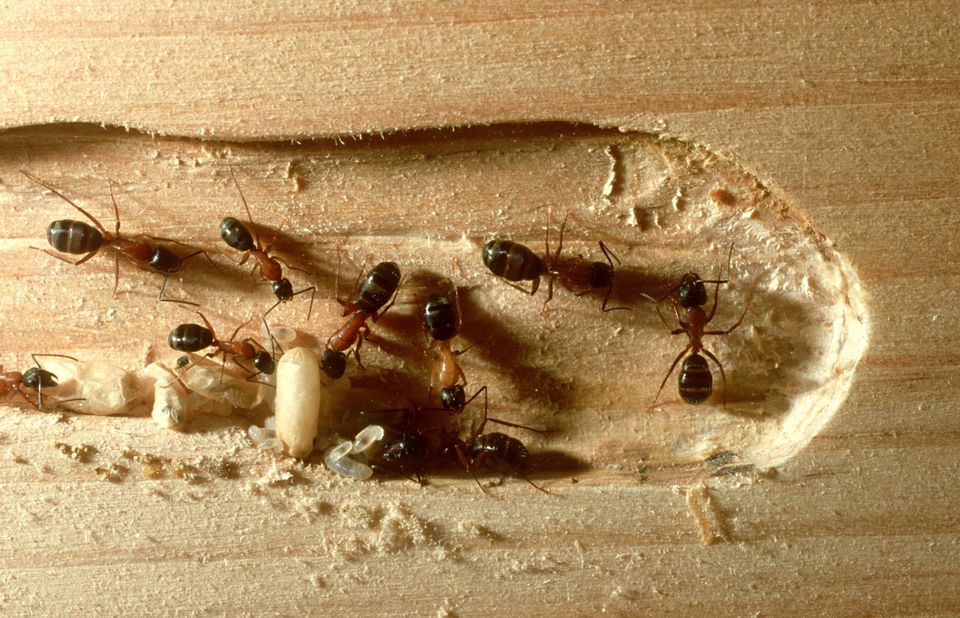
Hollow wood is another common sign of carpenter ants. Hollow wood is typically caused after extensive carpenter ant infestations in one area.
When the wood is previously damaged, such as water damaged or decaying smaller infestations can also hollow out the wood in some instances.
Typically, if you find stretches of hollow wood, this is a sign that the nest is nearby. Hollow patches of wood occur more often than most people expect.
This is because carpenter ants are unique in their nesting habits. There are known to create primary nests and satellite nests.
Satellite nests are secondary nests that are typically in harsher conditions than the primary nest. This typically includes higher temperatures and less moisture and humidity.
To create these nests, it’s common that carpenter ants will cause significant damage.
To check for hollow wood, you can knock on any wood beams for a hollow sound.
When inspecting areas for hollow wood, you will likely find smooth galleries and tunnels that lead to the hollow wood.
These tunnels are what carpenter ants are using or used to travel to their nest.
3. Wood Shavings / Frass
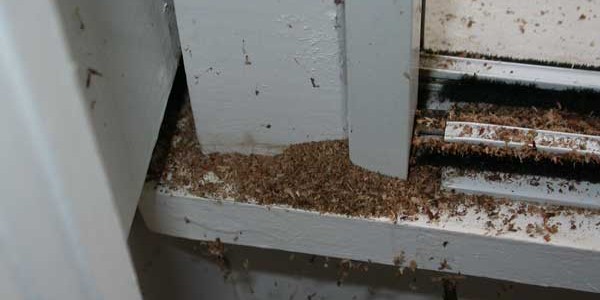
Wood shavings are another key sign that you have carpenter ants. When carpenter ants burrow into wood, they expel the remains of the wood outside of the wood.
These remains will look like small wood shavings. They are very fine and can be confused with frass or wood dust.
Termites and carpenter ants both leave wood shavings or frass behind. The main difference is that carpenter ants don’t eat wood like termites. Carpenter ants chew wood and push out the debris through small holes.
These wood shavings are commonly found on window frames, door frames, eaves, rafters, and other unfinished and exposed wood.
These exit holes are around ⅛ of an inch and are located on any wood surfaces that carpenter ants are infesting.
4. Overrun Food
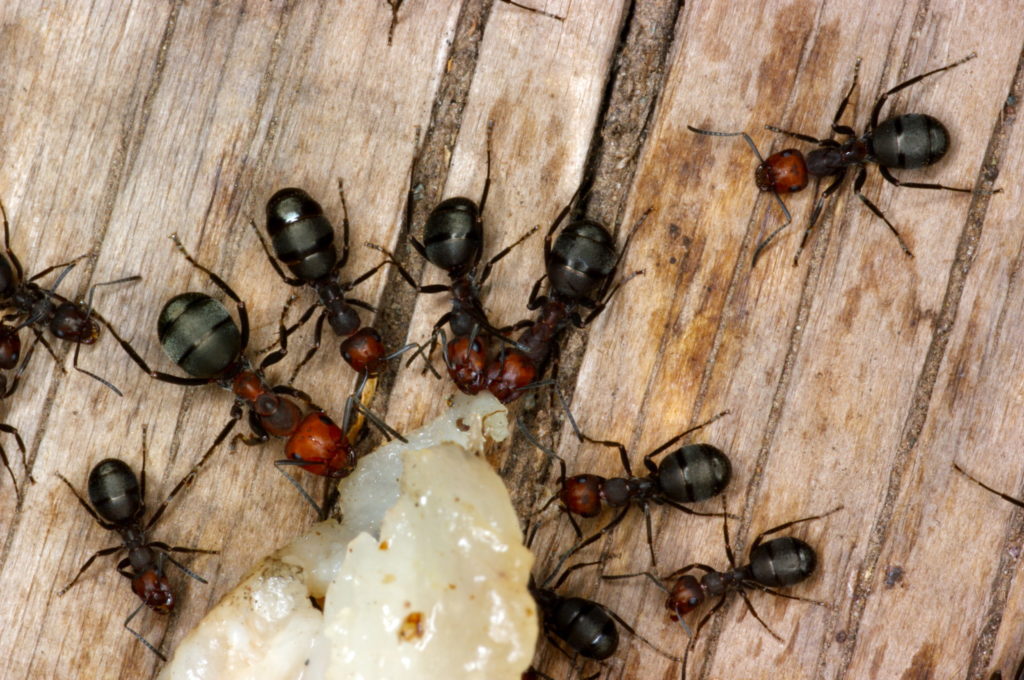
Ants inside your kitchen or invading your food are a sign of carpenter ants. Just like other ants, carpenter ants forage for food both indoors and outdoors.
Carpenter ants are versatile in their diet and will consume protein, sugars, or grease.
Outdoors you can find them near fruits, insects, gardens, or around arthropods. Indoors they will eat any human food, including sugar or grease.
Foragers will travel 300 feet and sometimes farther to forage for food.
If there are live ants inside or outdoor in your home, this is a sign that you have carpenter ants.
5. weird Noises
Weird noises are common with wood-boring insects such as carpenter ants and termites.
If you hear weird noises coming from your walls, ceiling, or other wood furniture, this is a sign of carpenter ant damage.
This is a sign that they have already begun creating tunnels inside the wood.
Depending on where the noise is coming from, the damage can be quite large.
The more frequent or loud the weird noises are, the more damage that is likely being caused to your home.
Both of these are signs that the infestation is large and that the damage is taking place at different places around your home all at once by multiple ants.
6. Exit Holes
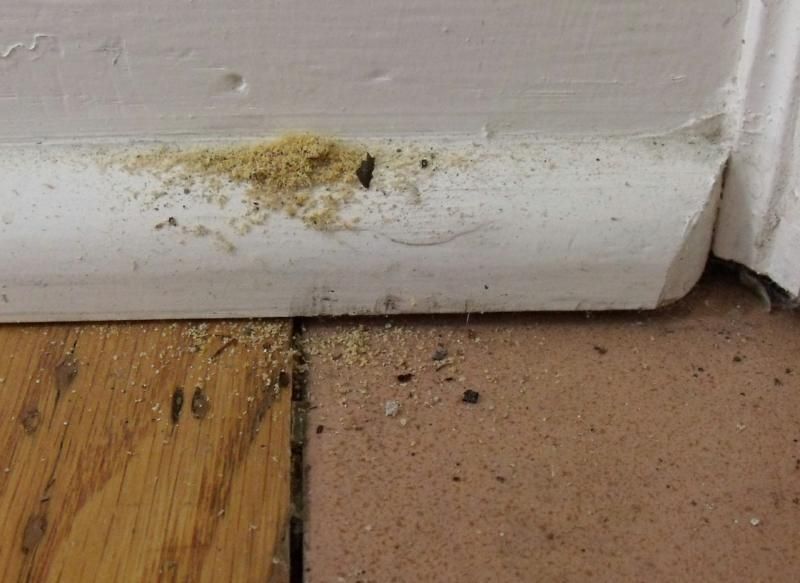
Carpenter ants create small exit holes that allow them to release debris from their galleries and tunnels.
This is one of the easiest ways to identify a wood-boring insect that has infested your wood.
You will find these on any wood that the carpenter ants have infested. Typically you will find small piles of wood dust, frass, or dead ants just below these holes.
It’s not uncommon to find exit holes on the same wood. If there are multiple holes in a small area, there is extensive damage taking place on this wood.
Typically, carpenter ants will create multiple exit holes if they need to eject lots of debris or two separate tunnels.
One way to make sure that it is carpenter ants is to expose the tunnel inside slightly. If the tunnel is smooth, then the tunnels are from carpenter ants. If the tunnels are rugged, then this is a sign you might have termites or other wood-boring animals.
7. Dead or Dying Trees
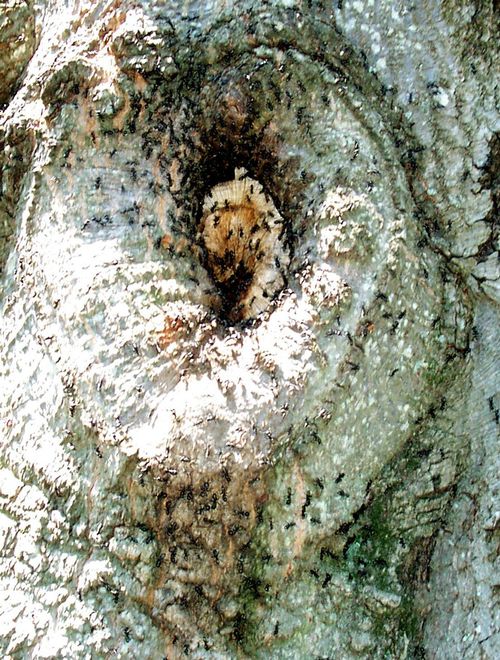
Another sign of carpenter ant damage is decaying or dying trees. Carpenter ants will infest rotting logs, wood, or trees.
Typically after carpenter ants infest a tree, you can expect to see the amount of dead or decaying wood begin to expand.
Once carpenter ants begin to nest inside a tree, they will cause the tree to die faster.
Some signs that there is a carpenter ant infestation on your tree includes
- Hollow wood
- Holes in wood
- Breaking branches
- Dying plants and trees
- Rotting wood
- Carpenter ant trails on tree
8. Flying Carpenter Ants
Flying carpenter ants are often overlooked as a sign of damage. The reality is that flying carpenter ants are a sign of a mature and expanding carpenter ant colony.
If you see flying carpenter ants, then this is a sign there is a well-established nest that has caused significant damage.
This is especially true if the flying ants are exiting from the wood inside your home or from the inside of a tree.
If there is a well-established colony inside your home that is capable of producing flying ants, there is likely significant damage.
You can use flying carpenter ants to try and locate the nest or the general area of the nest. First, you need to find the exit holes that the flying ants are coming from.
These exit holes are typically found on ceilings, window sills, door sills, eaves, walls, and crown moldings.
Once you find the exit holes, you can try to trace them back to their nest. You can do this by locating other damage and inspecting your home.
Even if you see flying ants outdoors, this could be a sign of damage outdoors inside trees or other wood structures.
If they are outside your home, this poses the danger of trying to invade your home and starting the damage on your home.
Whether you see flying ants indoors or outdoors, you should always be cautious and inspect thoroughly for infestations.
Types of Carpenter Ants
1. Camponotus Vicinus
This is often considered the most pervasive species of carpenter ants in the United States.
This species takes on the traditional color expected from carpenter ants, black and red. They tend to have a blackhead, read thorax and legs, and a black abdomen.
They are also easy to distinguish from other black ants because they are larger and have significantly larger abdomen. Even if you have black ants relatively the same size, the abdomen is always larger on the Camponotus vicious carpenter ant.
They can range from ¼” to ⅝,” making them a larger species of ant, which also makes them easier to differentiate between other ants.
2. Compontous Modoc or Black Carpenter Ants
These are considered to be western carpenter ants. These carpenter ants are widely spread throughout North America.
The main difference between this species of carpenter ant and other species is that these tend to be fully black. The only color other than black is the red or yellow hue of their legs.
The color of their legs can vary from red to yellow depending on the specific location they live in.
3. Compontous Ligniperda (Common Carpenter Ant In Europe)
The camponotus ligniperda is the most common species of carpenter ants found in Europe and Asia. This is the species that you will commonly find outdoors and inside homes.
This species of carpenter ant varies between quarter-inch and a little over half an inch long (1/4″-5/8″).
They are typically considered the black carpenter ants, although they tend to have red bodies. The compontous ligniperda tends to have a black head, red thorax or body, and black abdomen.
Another distinct characteristic compared to other species of ants is their large abdomen. These carpenter ants have a significantly large abdomen than other ant species. This includes workers and not only the queen.
Carpenter Ant Frass vs Termite Frass
Frass is a key sign of damage for both carpenter ants and termites. Unfortunately, the frass that they each produce is difficult to distinguish.
There are a few things that you can use to differentiate carpenter ant frass and termite frass.
Characteristics of Carpenter Ant Frass Includes:
- Insect body parts such as legs, arms
- Ant droppings inside the frass
- soil and gravel inside the frass
- larger fragments of wood
- dead ants
Characteristics of Termite Frass Includes:
- fine sawdust material
- subterranean termites produce pallets similar to pepper or coffee grounds
- More frass is found inside the hole
Is Carpenter ant damage covered by homeowners insurance?
No, most homeowners insurance policies don’t cover damaged causedby carpenter ants or other wood boring insects.
While damage such as destroyed wood or repairs are not covered with but in most cases, full collapses caused by pest damage are covered.
You should double-check your homeowner’s insurance to determine what types of damage are covered. If you are buying a new homeowners insurance policy remember to request or ask for a policy that includes damage by pests, vermin, or other rodents.
How To Get Rid of Carpenter Ants
1. Eliminate Food and Water Sources
Eliminate food and water sources around your home.
Removing these sources will help make sure that the ant will consume the bait you’re going to apply later.
Store your food items properly.
Place open food in airtight containers to minimize their scent.
Storing sweets such as honey and syrup is particularly essential.
You’ll also want to keep your pet food appropriately stored, as they are particularly appealing for Carpenter ants.
Do not leave empty soda bottles around your home.
You’ll also want to wipe the surfaces where you placed them to eliminate any sugary residue.
Finally, remove the garbage out of your home regularly.
2. Use Indoor and Outdoor Bait
Ant baits are regarded as the most effective way to treat Carpenter ant infestations.
Baits are a mixture of attractant and insecticide.
When a worker ant finds the bait, they take a portion of it and tell other workers to bring it back to the colony.
The ants will then place the bait in their food storage area, contaminating the rest of the food.
Eventually, the contaminated food and the bait will kill the entire colony.
The key to a successful bait strategy is using bait that ants are attracted to and placing them in the right locations.
Place ant baits in all the locations where ants were active during pre-baiting.
Also, use the same bait that the Carpenter ants consumed during pre-bait.
Indoor Baiting
For indoor baiting, the best option is to use gel bait or bait stations.
When baiting indoors, there are two options gel bait or bait stations.
One of the most effective and cost-effective indoor bait stations is the Terro liquid ant bait station.
It uses a borate and fructose solution, which is highly effective against ants.
Another great option is the Rescue Ant Bait, which offers protein and sugar to the ant and uses borate as the active ingredient.
When using gel baits, Maxforce Ant Gel Bait is one of the most effective brands.
Both of these baits are sugar-based gel baits.
It uses fipronil as an active ingredient, which is a non-repellent that is extremely effective against ants.
Outdoor Baiting
For outdoor use, the best option is to use outdoor refillable bait stations.
Knees or Bait No More bait stations are easy to use and will last a lifetime so you can continue killing any active ant infestations around your home.
To get started all you have to do is insert the stake into the ground and then add the bait.
These are easy to refill and can be used for a lifetime to kill carpenter ants trying to approach your home.
It’s also important that you place the bait outside, make sure to put it in the shade, as extreme to sunlight can reduce its potency.
When using bait stations, you can use either liquid or granular bait to attract ants.
Liquid bait options include Thiquid, which is a borate and sugar-based solution.
Granular options such as the Maxforce complete granular bait are excellent options for baiting with fructose, while Advance 375A Granular Bait is a great option for protein-based baiting options.
Depending on which pre-bait your carpenter ants were consuming, choose the appropriate granular bait.
3. Apply Non-Repellent Spray
While bait should be enough to eliminate carpenter ants, using non-repellent is a great way to boost protection.
Unlike pesticides, the non-repellants spray is undetectable to ants.
They will walk right over it and bring toxic chemicals back to their colony.
The chemical will kill all members, including the queen.
To use non-repellant spray, apply it where the ants live and travel outdoors.
The non-repellent spray is often used to create a barrier around your home.
This is typically done by spraying a 3-foot wide area around the foundation of your home, as well as 3 feet up the walls of your home.
Any ants that try to approach your home and enter will be infected with insecticide and slowly begin to die.
You can also spray it directly on ant trails. While this won’t kill them, it will deliver a large amount of insecticide back to the nest.
Avoid spraying or drenching ants nests with non-repellent insecticides.
These are slow-acting and this can give ants sufficient time to leave the nest and form a new nest somewhere else before they all die.
4. Treat Voids And Tunnels
Void treatment may be a good idea if the carpenter ants live inside the walls or ceiling of your home.
This method is a bit intrusive, so I recommend starting with the bait. If that doesn’t eliminate the ants, then void treatments is a great option.
To do this, drill holes ⅛ inch deep into your wall. Next inject the wall with a non-repellant spray.
Once done, make sure to fill the voids to prevent the ants from coming back.
One of the most popular forms of non-repellent spray is foam sprays.
You can inject these into any drilled holes, cracks, crevices, or voids you may find indoors or outdoors.
The foam will expand throughout the entire void, and any ants that come into contact with the foam will bring the insecticide back to the colony.
5. Fix Plumbing Issues
Carpenter ants need to be close to water to survive. They are also most attracted to damp wood.
To eliminate both, make sure you:
Fix any leaks under your kitchen and bathroom sinks.
Repair significant condensation on your pipes.
Fix your roof and attic for any leaks when it’s raining.
Remove any faucet leaks in your kitchen and bathroom.
Fix any toilet leaks.
Check for floor water stains on your floor and find where it’s coming from.
Make sure your rain gutters, downspouts, and splash blocks are functioning correctly.
They should keep the water at least five feet minimum from your foundation wall.
6. Fill Any Voids
Ants are tiny and can get through the smallest crevices and holes.
To prevent them from infesting your home, fill any voids on your walls and floors with the appropriate material.
Caulk cracks and crevices that offer any entrance from the outside of your home.
